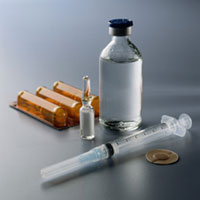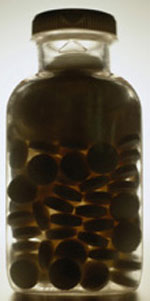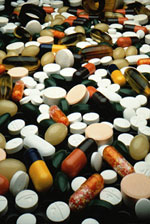Fake medicines are everywhere
On a daily basis, many unknowingly risk death

Fake medicines may kill. At the very least, they are not effective against a disease or an ailment.
Injectables that contain ordinary liquid composed of water and oil and mixed with starch or talc "are particularly fatal," says Normita Leyesa, president of the 48,000-strong Philippine Pharmaceutical Association.
"It is a nationwide problem," she continues. "In Pampanga alone, P5 million in fake drugs were seized late last year."
Buy-bust operations launched by the Department of Health's Bureau of Food and Drugs (BFAD) has unearthed fake medicines in diverse places such as Nueva Ecija, Misamis Oriental and Zamboanga and General Santos cities.
Some of the fake medicines seized included multivitamins, cefazolin, cefuroxime, dydrogesterone, loperamide, gliclazide and dexamethasone.
Leyesa warns there have been several cases of deaths. "There have been reports of adverse effects ranging from itchiness to dizziness, from swollen eyes to difficulty in breathing or, worse, the fake drugs affect internal organs."
Some counterfeits have no ingredients at all contrary to what they claim on the labels. Others are watered-down versions of the real ones. All the same, they defraud consumers and deny ill patients the therapies that ease suffering and save lives.
"There are two ways patient are affected, either by adverse side-effects or that the patient is not cured or eventually dies if it is a fatal disease because there are insufficient ingredients or no active ingredient in the fake medicines at all," Leyesa tells InterNews&Features.
 Counterfeit medicines, as defined by the Special Law on Counterfeit Drugs, refer to the drug itself, or the container or labeling without any likeness to that which is owned or registered in the Bureau of Patent, Trademark and Technology Transfer. It is considered fake if a drug product is refilled in containers by unauthorized persons and the legitimate labels are used.
Counterfeit medicines, as defined by the Special Law on Counterfeit Drugs, refer to the drug itself, or the container or labeling without any likeness to that which is owned or registered in the Bureau of Patent, Trademark and Technology Transfer. It is considered fake if a drug product is refilled in containers by unauthorized persons and the legitimate labels are used.
An unregistered imported drug product -- except those brought in the country for personal use -- is also considered counterfeit. Then there are the drugs which contain no amount of, or a different active ingredient, or less than 80% of the active ingredient it claims to possess.
Fake medicines affect the very people who need real, quality drugs the most: cancer and AIDS patients and those with heart diseases.
Of the 30 medicines the US National Association of Boards of Pharmacy named in a list of medicines especially susceptible to counterfeiting, 23 are used in treating HIV/AIDS and cancer.
Counterfeiters favor these medicines because of their cost. Sixty tablets of a particular anti-HIV drug retails for around $600. Thirty-six tablets of an anti-nausea medicine used by people undergoing cancer chemotherapy, retails for roughly $1,000.
Over the previous two years, 110,000 bottles of counterfeit medicines -- used to boost red blood cell production in people with cancer, AIDS and kidney disease -- made their way into the US market. Law enforcement officials there recovered only one-tenth of the counterfeit drugs.
"On a daily basis, many individuals unknowingly risk death or serious injury to their health by taking counterfeit pharmaceuticals," according to the Pharmaceutical Security Institute (PSI), a non-profit corporation formed by drug companies, including the 15 largest drug manufacturers, to collate information on fake medicines.
Counterfeit medicines account for a small fraction of a percent of the more than 3 billion prescriptions filled each year in the United States. But in 2003, the US FDA recalled 200,000 bottles of a popular cholesterol-lowering drug that were believed to be fake.
In the Philippines, according to the Samahan Laban Sa Pekeng Gamot, anything from cough syrups to life-saving antibiotics could be counterfeit.
 The Samahan is composed of the departments of health, trade and justice, the Philippine Medical Association, Philippine Pharmaceutical Association, Drugstores Association of the Philippines, Mercury Drug Corporation, Watson's Personal Care Stores, Zuellig Pharma Corporation, Philippine Daily Inquirer, GMA Network, Inc. and Pfizer.
The Samahan is composed of the departments of health, trade and justice, the Philippine Medical Association, Philippine Pharmaceutical Association, Drugstores Association of the Philippines, Mercury Drug Corporation, Watson's Personal Care Stores, Zuellig Pharma Corporation, Philippine Daily Inquirer, GMA Network, Inc. and Pfizer.
The Samahan has a toll-free hotline (1-800-10-FAKEMED) where any information on suspicious counterfeit medicines can be reported.
The problem is not unique to the country. The estimated 192,000 patients killed by fake medicines in China in 2001 gives an indication of the scale of human suffering.
There, health authorities found that 13% of pharmaceuticals were counterfeit or of substandard quality. In Nigeria and the Ukraine, it is estimated that 40% of the drug supply is counterfeit. Fully one-half of all medicines in Pakistan are believed to be fake.
A recent World Health Organization (WHO) report suggests that India is responsible for about 35 % of the world's production of counterfeit medicines. One in every four medicines sold in India is fake, it says.
At least 11 states in India do not have laboratories for testing medicines. In 15 states with functional laboratories, only seven were adequately equipped and staffed.
During a meningitis epidemic in Nigeria in 1995, more than 50,000 people were inoculated with fake vaccines donated by a country which thought they were safe. The error resulted in 2,500 deaths.
The consumption of paracetamol cough syrup prepared with diethylene glycol (a toxic chemical used in antifreeze) led to 89 deaths in Haiti in 1995 and 30 infant deaths in India in 1998.
The US FDA estimates that up to 15% of all sold medicines are fake, and in parts of Africa and Asia this figure exceeds 50%. It also estimates that fake medicines comprise approximately 10% of the global medicine market.
InterNews&Features
